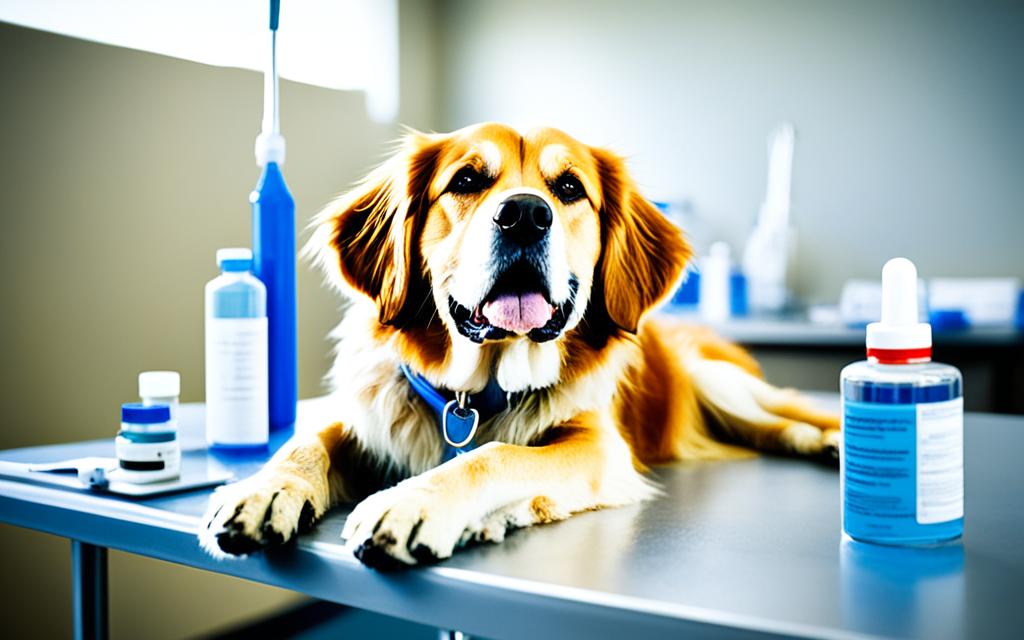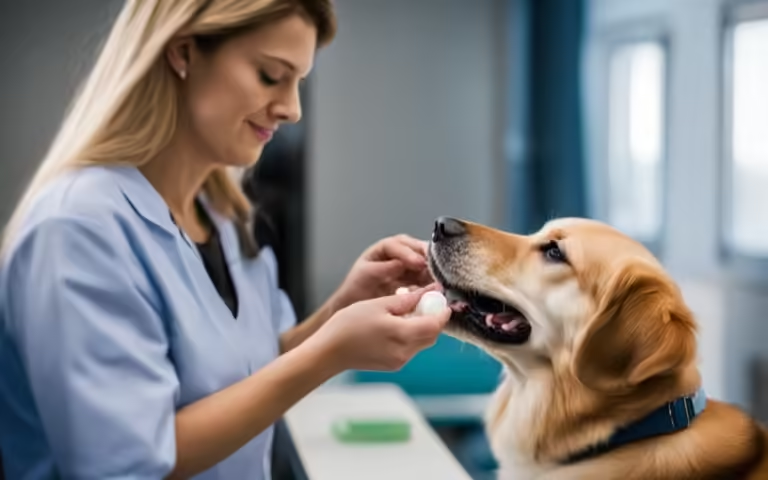Acepromazine Maleate for dogs
Did you know that over 60% of pet owners feel anxious about taking their dogs to the vet? This worry is common, from regular check-ups to more serious visits. For pet owners and vets, Acepromazine Maleate comminly known as ‘ACE’ is a big help. It’s a sedative and tranquilizer for pets, offering a safe way to ease their anxiety.
Key Takeaways:
- Acepromazine Maleate is a sedative and tranquilizer used in veterinary medicine for dogs.
- It helps manage pet anxiety and stress during vet visits and procedures.
- Acepromazine can be administered as an injection, tablet, or oral liquid.
- It is essential to follow your veterinarian’s dosage and administration guidelines.
- Discuss the use of Acepromazine with your veterinarian to ensure safe and appropriate use for your dog.
Table of Contents
Understanding the Mode of Action of Acepromazine
Acepromazine is often used in veterinary medicine to calm animals. It mainly works by changing dopamine levels in the brain. This leads to sedation, muscle relaxation, and a drop in activity.
It also acts in other ways. For example, it can relax certain muscles and block some brain signals. This helps in many medical cases. But, it’s essential to know that it doesn’t ease pain in animals.
When given, acepromazine lowers the blood pressure. This can affect the heart rate, breathing, and how well the animal controls its temperature.
Knowing how acepromazine works is key for vets and pet owners. It lets them choose when to use it safely and understand its effects on dogs.
The Effects of Acepromazine:
- Sedation
- Muscular relaxation
- Reduced spontaneous activity
Acepromazine should always be used under a vet’s guidance. They know the right dose for your dog. They can also check if it’s safe for your pet’s health.
Benefits and Uses of Acepromazine for Dogs
Acepromazine is a popular sedative for dogs that offers many benefits. It can help with anxiety and stress. This makes it a go-to tranquilizer for dogs in various states.
It’s a great pre-anesthetic because it sedates effectively. Giving acepromazine before a procedure cuts down on anxiety. It helps dogs have a smoother time with the anesthesia. This means less stress and lower anesthesia doses, reducing risks.
Besides pre-anesthetic use, acepromazine can tackle motion sickness in dogs. If your dog gets sick in cars or on trips, this can help. It makes travel more pleasant for them.
It also works well for allergies, reducing itch and scratch. As an anti-itch medicine, it soothes skin allergies. This also stops dogs from damaging their skin by scratching too much.
Acepromazine isn’t just for medical situations. It’s also key for settling dogs during visits, nail cuts, or grooming. It makes these experiences less stressful for dogs and their humans.
Off-Label Uses of Acepromazine
While acepromazine is known as a dog sedative, it has off-label uses too. For example, it might help with cat urinary issues or horse laminitis. These uses show its broad application and usefulness in different animals.
For the right use and dosage of acepromazine, talking to your vet is key. They’ll consider your dog’s health and needs. This ensures the sedative is given correctly and safely.
Administering Acepromazine to Dogs: Dosage and Administration Guidelines
Administering acepromazine to dogs requires following proper dosage and administration guidelines. The amount needed varies by size, age, and health status. Always consult your vet to pin down the right dose for your pup.
You can give acepromazine in pill, liquid, or shot form. Usually, it’s given by mouth, which is mixing it with food or straight into their mouth.
Timing is key when using acepromazine. Give it 45 minutes to an hour before you need your dog to be calm. This ensures it has enough time to start working.
The response to acepromazine might differ. Some might need more for sedation, others less. This can depend on their individual reactions.
Remember, acepromazine is a prescription drug. Always follow your vet’s advice on dosage. Avoid giving or changing the dose on your own. If you’re unsure, ask your vet for help.
| Weight Range | Acepromazine Dosage |
|---|---|
| 10-25 lbs | 2-5 mg |
| 26-50 lbs | 5-10 mg |
| 51-100 lbs | 10-25 mg |
| Over 100 lbs | 25-50 mg |
Potential Side Effects and Precautions of Acepromazine
Acepromazine is a sedative often used by vets. But, it’s crucial to know the side effects and be careful. This helps keep your pet safe and healthy.
Acepromazine Side Effects:
- Low blood pressure: A common effect is lower blood pressure. Severe cases can lead to heart issues. So, watch your pet closely. If they seem weak, tell your vet.
- Decreased tear production in cats: Cats’ eyes may get dry. This can make them uncomfortable. If your cat’s eyes are dry, get advice from your vet.
- Temporary injection site pain in dogs: Some dogs might feel a bit of pain where they got the shot. But it goes away on its own. No need to worry.
- Mildly discolored urine: Your pet’s urine might look a bit odd on this drug. It’s usually nothing to worry about.
Acepromazine Precautions and Contraindications:
Despite its general safety, there are some important things to avoid or be careful with when using acepromazine:
- Avoid using it on pets that react badly to certain substances.
- Pets with some serious health conditions should not get this drug. These include heart issues and very low blood pressure.
- Be careful with pets that have liver or heart problems, or those who can’t clot blood well.
- If your pet is debilitated, pregnant, or very young, or if they’re a certain breed, their acepromazine needs special attention. This may include the dosage.
It’s very important to tell your vet about all your pet’s medications. This helps prevent dangerous drug interactions. Your vet knows best how to safely use acepromazine for your pet’s unique situation.

| Side Effect | Precautions |
|---|---|
| Low blood pressure | Monitor closely for signs of weakness or lethargy |
| Decreased tear production in cats | Contact your veterinarian if ocular dryness occurs |
| Temporary injection site pain in dogs | Resolves within a short period of time |
| Mildly discolored urine | Generally harmless and does not require intervention |
Comparison with Similar Drugs in the Sedative Category
Acepromazine is widely used to sedate dogs. But it’s important to look at other options too. Different sedatives work better for certain situations or dogs.
Benzodiazepines are another choice besides Acepromazine. These include diazepam and alprazolam. They boost the effect of a brain chemical called GABA, which calms the brain and causes sedation. They are often picked for dogs with anxiety.
There are also alpha-2 agonists like dexmedetomidine to think about. They work by acting on a certain brain receptor. This reduces brain activity, bringing about sedation and pain relief.
The best sedative choice depends on many factors. These include how sedated you want your dog, how long it should last, side effects, cost, and how your dog reacts. It’s key to talk deeply with a vet to choose wisely.
Cost is an important factor too. While Acepromazine is usually cheaper, it’s good to check the prices of other sedatives. This will help you find one that fits your budget and keeps your dog safe.
Talking to a vet experienced with your dog’s needs is crucial. They can offer the best advice on sedatives. Their knowledge of both your dog and the available medicines is key.
When thinking about sedatives for your dog, do your research. Look into Acepromazine, benzodiazepines, and alpha-2 agonists like dexmedetomidine. Compare their pros and cons, how long they work, and the cost. This will help you choose the best option for your dog’s sedation, ensuring their well-being.
Storage and Emergency Guidelines for Acepromazine
Acepromazine is often used to calm dogs. It’s key to store it well to keep it safe and effective. Here’s how to store acepromazine the right way:
- Put acepromazine in a dark spot, away from light. Light can make the medicine not work as well.
- Keep the tablets in a closed container. This stops them from getting moist or losing quality from the air.
- ACEpromazine should be kept at room temperature. That’s between 20-25 degrees Celsius (68-77 degrees Fahrenheit).
If you think there’s an acepromazine overdose, act fast. These are the steps to follow in an emergency:
- Talk to your vet right away. They’ll help you based on your dog’s needs and tell you what to do.
- If you can’t reach your vet, call an emergency pet hospital. Your vet will have instructions for this.
- Know how much medicine your dog took and when they took it. Share this info with the vet or hospital.
- Keep an eye out for these signs of too much acepromazine: More sleepy than usual, trouble breathing, strange heartbeats, or seizures.
- Always have the Poison Control number (800-222-1222) handy. They can give you more help for a medicine overdose.
Following these steps for storage and emergencies will keep your dog safe. It’s important to know what to do with acepromazine.
Monitoring and Follow-up Care for Dogs on Acepromazine
Your vet might suggest keeping an eye on your dog’s heart and blood when they’re on acepromazine. This is more important if your dog isn’t too healthy or they’ve been on acepromazine for a while. It’s key to listen to your vet and give them updates on your dog’s health while taking this medication.
During check-ups, your vet will see how your dog is doing on acepromazine. They’ll watch for any issues and tweak the medicine or plan if needed.
It’s also vital to keep in touch with your vet about your dog’s daily changes. If your dog acts different or seems off, don’t wait. Call your vet right away.
Your dog may need more tests to make sure the medication is helping without any bad effects. How often you go back to the vet depends on your dog’s condition and how they react to acepromazine.
Make sure your dog is in a calm, stable place while taking acepromazine. Reduce any stress, stick to a schedule, and keep their food and water fresh. This helps your dog feel good.
Key Monitoring Guidelines for Dogs on Acepromazine:
- Keep an eye on heart rate, rhythm, blood pressure, and body temperature
- Tell your vet about behavior or health changes
- Call your vet if you see something strange or your dog gets worse
- Do any extra tests or checks the vet recommends
- Give your dog a safe, comfy home
| Monitoring Parameters | Frequency |
|---|---|
| Heart rate | Weekly |
| Heart rhythm | Weekly |
| Blood pressure | Monthly |
| Body temperature | As needed |
Acepromazine Overdose Information
Sometimes, an acepromazine overdose happens by mistake, or the dosage is wrong. It’s key to know the signs of an overdose and what to do. This helps avoid serious problems.
Acepromazine overdose symptoms:
- Excessive sedation
- Slow respiratory and heart rate
- Pale gums
- Unsteady gait
- Poor coordination
- Inability to stand
More serious symptoms might also show up:
- Sudden collapse
- Unconsciousness
- Seizures
- Death
If you think your dog has had too much acepromazine, quick action is vital. Get in touch with your vet, an emergency clinic, or a pet poison control. They will tell you what to do next.
Acepromazine overdose treatment:
The way an acepromazine overdose is treated depends on how bad the symptoms are and the dog’s health. Vets work to make the dog stable and tackle the overdose effects.
To deal with low blood pressure, which acepromazine can cause, drugs like phenylephrine and norepinephrine might be used. These drugs can help bring blood pressure back to safe levels and fight the drug’s sedative effects.
For seizures, your vet might use barbiturates or diazepam. These drugs can help manage the seizures and keep your dog safe.
| Acepromazine Overdose Information | Treatment |
|---|---|
| Excessive sedation | Monitor and provide supportive care |
| Slow respiratory and heart rate | Administer medications to stabilize heart and respiratory function |
| Pale gums | Monitor and evaluate blood pressure and circulation |
| Unsteady gait | Provide a stable and safe environment |
| Poor coordination | Administer supportive care and monitor for improvement |
| Inability to stand | Monitor and assist with mobility as needed |
Conclusion
Acepromazine Maleate helps calm and sedate dogs. It’s a trusted choice for vets to prepare animals for surgery. This drug can be given in many ways, like shots, pills, or liquid by mouth. This variety makes it easier to use.
Even though it’s mostly safe, being careful is key. Knowing the possible bad effects is important too. Always use it as your vet tells you to.
Your vet is the best person to guide you when using acepromazine. They’ll tailor the advice to fit your furry friend’s health. Asking them questions is a smart move.
In short, Acepromazine Maleate is very useful in pet care. It keeps dogs calm and safe. But you should learn how to use it right. With help from your vet, it can be a great aid for your dog.
FAQs about Acepromazine Maleate for dogs
What is Acepromazine Maleate?
Acepromazine Maleate is a sedative for dogs and cats. It’s also known as acetylpromazine or PromAce®
How does Acepromazine work?
This drug lowers dopamine levels in the brain. It slows down the nervous system, making animals calm and relaxed.
What are the benefits and uses of Acepromazine for dogs?
It helps dogs feel less anxious and more relaxed. Vets use it before operations and to keep dogs still during exams. It also stops them from feeling sick during trips.
How should Acepromazine be administered to dogs?
Vets decide the right amount based on each dog’s size and health. You can give it in a pill, liquid, or by injection.
What are the potential side effects and precautions of Acepromazine?
It may make pets’ blood pressure drop and eyes dry up. It’s not for pets with some heart issues or certain drug exposures.
How does Acepromazine compare to other sedatives?
It’s a common choice for calming dogs before vet visits or surgeries. There are other options, depending on the situation or pet’s needs.
How should Acepromazine be stored, and what are the emergency guidelines?
Keep it away from light at room temperature. If your pet gets too much, seek help from a vet right away.
What monitoring and follow-up care is required for dogs on Acepromazine?
Your vet might want to check your dog’s vitals often, especially with long-term use or if your dog is not well.
What should I do in case of an Acepromazine overdose?
Get help from a vet, an emergency clinic, or a poison control center. Quick action is crucial if too much is taken.
What should I know about Acepromazine Maleate for dogs?
It’s a widely used sedative for dogs. Always follow your vet’s advice and discuss your dog’s needs with them.







